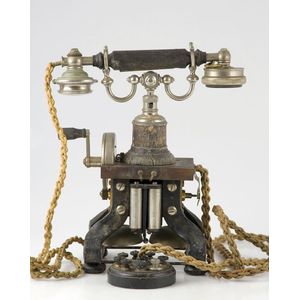Japanned Skeleton Telephone with Bells
You must be a subscriber, and be logged in to view price and dealer details.
Subscribe Now to view actual auction price for this item
When you subscribe, you have the option of setting the currency in which to display prices to $Au, $US, $NZ or Stg.
- Japanning - Japanning is the early eighteenth century technique used by European craftsmen to imitate the oriental style lacquer work that became popular in England, France, the Netherlands, and Spain in the 17th century.
The lacquer used was based on the lac beetle dissolved in alcohol (as used in French polish) and differed from the Chinese lacquer which was based on tree sap.
Each layer of the lacquer was allowed to dry and then sanded down. It was applied over cream, yellow, green, red, or black grounds. Japanning using gold leaf was also widely used with lacquer work. The technique can be found on bureaux, cabinets, chests, longcase clocks, and chairs. - Gilding - Gilding is a method of ornamentation whereby a thin sheet of gold metal is applied to items made of wood, leather, ceramics, glass and silver for decorative purposes.
For furniture including mirrors, the sheet of gold is usually applied over a coating of gesso. Gesso is a mixture of plaster of Paris and gypsum mixed with water and then applied to the carved wooden frames of mirrors and picture frames as a base for applying the gold leaf. After numerous coats of gesso have been applied, allowed to dry and then sanded a coat of "bole", a usually red coloured mixture of clay and glue is brushed on and allowed to dry, after which the gold leaf is applied. Over time parts of the gilding will rub off so the base colour can be seen. In water gilding, this was generally a blue colour, while in oil gilding, the under layer was often yellow. In Victorian times, gilders frequently used red as a pigment beneath the gold leaf.
Metal was often gilded by a process known as fire gilding. Gold mixed with mercury was applied and heated, causing the mercury to evaporate, the long-term effect of which was to kill or disable the craftsman or woman from mercury poisoning. The pursuit of beauty has claimed many victims, not the least of which were the artists who made those pieces so highly sought after today.
This item has been included into following indexes:
Visually similar items

A large and impressive pair of bronze and gilt bronze figural candelabra, French, 19th century, each on a stepped rouge marble base, 138 cm high

19th century French candelabra. Gilt bronze ormolu finish. Urn finial between two candle branches. Bronze. Height 25 cm

A Regency ormolu three branch candelabrum, circa 1830. The branches supported by a putto figure set upon a marble base with four ormolu feet, 56 cm high.

A brass Arts & Crafts ceiling light fitting of coronet form set with simulated moonstones and with hangers to suspend a glass shade. Diameter 22.5 cm
